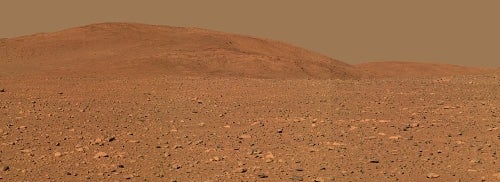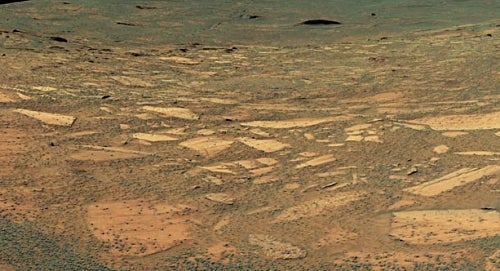We’re beginning to see links between the two sites visited by the rovers,” says Mars Exploration Rover chief scientist Steve Squyres (Cornell University). “It’s not the story we expected to see,” he adds, noting that while evidence for water proved abundant in Meridiani Planum, it has remained elusive and marginal in Gusev Crater — up to now.
However, rover science team member Johannes Brueckner (Max-Planck-Institut für Chemie, Mainz, Germany) reports that inside trenches made by Spirit’s wheels in two locations, the rover’s alpha-particle X-ray spectrometer detected elevated quantities of magnesium and sulfur that appear chemically bound as magnesium sulfate, or Epsom salts.
Squyres attributes the magnesium sulfate to a slow process of acidic water percolating through the soil and dissolving minerals from the rock particles present. As water reached the surface, it evaporated, leaving the minerals behind. But the deposition process was slow: “This isn’t like an ocean or a lake,” Squyres says, contrasting it with the conditions at the Eagle Crater site, where open water flowed on the surface in ponds or a sea.
With the martian autumn advancing, Spirit now has traveled more than 2 miles (3 kilometers) across the surface of Gusev from its landing site. It has rolled to a stop just 100 yards (meters) from the base of the Columbia Hills, its next target.
“We don’t have a clue what the hills are made of,” says Squyres. He emphasizes that ahead lies a months-long program of exploration. Scientists want to identify the rock units making up the Columbia Hills, see if they are sedimentary or volcanic, and determine what they say about the history of Gusev Crater.
The plan is to drive about 15 to 25 feet (4 to 8 meters) straight down the slope, staying mostly on the rock, which tests on Earth have determined gives the best traction for the rover’s ribbed aluminum wheels. To return to the rim, Opportunity will back up in reverse gear. Mission engineers will make two or three incremental forays with Opportunity, testing the traction as the slope steepens, before committing to a full descent.
For scientists, the goal is to reach a layer of rock that weathers like sedimentary sandstone but has the spectral signature of basalt, a volcanic rock.
“Was it deposited in deep, standing water?” asks Squyres, “As sand dunes? By some volcanic process?” The scientists also are interested in examining the contact between the sulfate layer and the sandstone — whether the change was gradual or abrupt will tell scientists about changes in the environment at the site. Squyres continues: “The sulfate rock at the rim represents the last chapter in the geologic story, when the lake or ocean dried up. We want to see what came before.”
Going into Endurance now represents a change from scientists’ original plans. These called for Opportunity to survey the crater’s entire rim first and then revisit some sites (such as the Anatolia fractures and Fram Crater) that were examined only hastily on the dash to Endurance. What has changed the plan is a growing concern over declining battery power and the advancing season, which is decreasing the amount of sunlight available for recharging the rover’s batteries.
Making the concern critical is a heater located at one joint in the rover’s instrument arm. It has stuck in the “on” position and draws a lot of power whenever the rover is awake. Mission control has dealt with this by adopting a deep-sleep mode that shuts down the rover each night, turning off all the heaters.
However, the mini-thermal emission spectrometer (mini-TES), a key instrument for determining the composition of rocks, likely will fail when temperatures reach -50° C to -60° C (-58° F to -76° F). As overnight lows are approaching these temperatures, the rover has to make the descent now or it will lose the ability to use mini-TES at close range on the outcrop.
When asked what science would be lost if Opportunity gets stuck in the crater, Squyres appears unfazed, saying, “We’d be giving up the chance of driving several kilometers to the south to visit exposures of the same stuff we see here.”
Whatever happens in Endurance, he says, “we can’t lose.”












